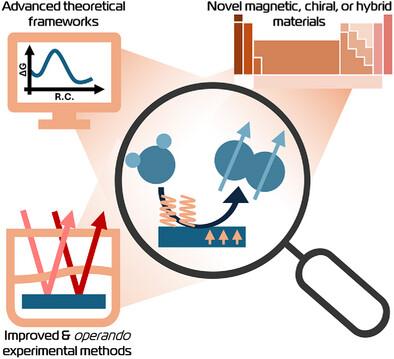Spin Matters: A Multidisciplinary Roadmap to Understanding Spin Effects in Oxygen Evolution Reaction During Water Electrolysis
IF 26
1区 材料科学
Q1 CHEMISTRY, PHYSICAL
引用次数: 0
Abstract
A central challenge in water electrolysis lies with the oxygen evolution reaction (OER) where the formation of molecular oxygen (O2) is hindered by the constraint of angular momentum conservation. While the reactants OH− or H2O are diamagnetic (DM), the O2 product has a paramagnetic (PM) triplet ground state, requiring a change in spin configuration when being formed. This constraint has prompted interest in spin-selective catalysts as a means to facilitate OER. In this context, the roles of magnetism and chirality-induced spin selectivity (CISS) in promoting the OER reaction have recently been investigated through both theoretical and experimental studies. However, pinpointing the key principles and their relative contribution in mediating spin-enhancement remains a significant challenge. This roadmap offers a forward-looking perspective on current experimental trends and theoretical developments in spin-enhanced OER electrocatalysis and outlines strategic directions for integrating incisive experiments and operando approaches with computational modeling to disentangle key mechanisms. By providing a conceptual framework and identifying critical knowledge gaps, this perspective aims to guide researchers toward dedicated experimental and computational studies that will deepen the understanding of spin-induced OER enhancement and accelerate the development of next-generation catalysts.

自旋问题:了解水电解过程中析氧反应中自旋效应的多学科路线图
水电解的核心挑战在于析氧反应(OER),其中分子氧(O2)的形成受到角动量守恒约束的阻碍。当反应物OH−或H2O具有抗磁性(DM)时,O2产物具有顺磁性(PM)三重态基态,在形成时需要改变自旋构型。这一限制引起了人们对自旋选择性催化剂作为促进OER的手段的兴趣。在这种背景下,磁性和手性诱导的自旋选择性(CISS)在促进OER反应中的作用最近已经通过理论和实验研究进行了研究。然而,确定关键原则及其在调节自旋增强方面的相对贡献仍然是一项重大挑战。该路线图为当前自旋增强OER电催化的实验趋势和理论发展提供了前瞻性的视角,并概述了将深刻的实验和操作方法与计算建模相结合以解开关键机制的战略方向。通过提供一个概念框架和确定关键的知识差距,这一观点旨在指导研究人员进行专门的实验和计算研究,从而加深对自旋诱导OER增强的理解,并加速下一代催化剂的开发。
本文章由计算机程序翻译,如有差异,请以英文原文为准。
求助全文
约1分钟内获得全文
求助全文
来源期刊

Advanced Energy Materials
CHEMISTRY, PHYSICAL-ENERGY & FUELS
CiteScore
41.90
自引率
4.00%
发文量
889
审稿时长
1.4 months
期刊介绍:
Established in 2011, Advanced Energy Materials is an international, interdisciplinary, English-language journal that focuses on materials used in energy harvesting, conversion, and storage. It is regarded as a top-quality journal alongside Advanced Materials, Advanced Functional Materials, and Small.
With a 2022 Impact Factor of 27.8, Advanced Energy Materials is considered a prime source for the best energy-related research. The journal covers a wide range of topics in energy-related research, including organic and inorganic photovoltaics, batteries and supercapacitors, fuel cells, hydrogen generation and storage, thermoelectrics, water splitting and photocatalysis, solar fuels and thermosolar power, magnetocalorics, and piezoelectronics.
The readership of Advanced Energy Materials includes materials scientists, chemists, physicists, and engineers in both academia and industry. The journal is indexed in various databases and collections, such as Advanced Technologies & Aerospace Database, FIZ Karlsruhe, INSPEC (IET), Science Citation Index Expanded, Technology Collection, and Web of Science, among others.
 求助内容:
求助内容: 应助结果提醒方式:
应助结果提醒方式:


